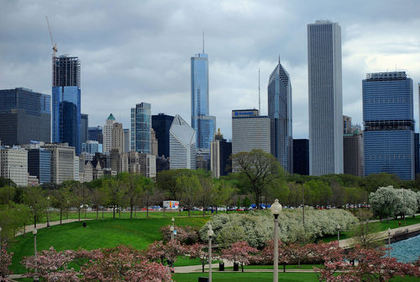Grant Park - Chicago, IL
Grant Park is a classic centerpiece of one of America's grandest cities. Chicago is characterized by its architectural beauty as well as its forward thinking in urban planning practices and preservation of key open space. One of the main attractions in the city is the uninterrupted greenway that spans the significant length of the shore of Lake Michigan. Due to the size of the lake, it is almost as if one were on the edge of a vast sea or even ocean, as you can not see the other side of the lake from Chicago. Confronting the lake from the heart of downtown is Grant Park, which serves as an invaluable civic treasure to the city as well as one of the nation's finest waterfront parks.
With a size of 319 acres, Grant Park commands an incredibly large amount of real estate in the heart or the urban bustle of the city. It is surrounded on three sides by skyscrapers and a heavily dense urban environment. On the fourth side is the tranquility offered by Lake Michigan, which serves a very valuable purpose for the quality of life in the city. The park allows urban dwellers and workers alike public access to this desirable area and presents an area for relaxation, recreation, or various other opportunities that are otherwise limited in the heart of the nation's third largest city. Due to its location and amenities, the park is often referred to as "Chicago's Front Yard". This term is attributable to the fact that locals treat the park as a daily fabric of their lives and use for various purposes as if it were their own. In that aspect, Grant Park is truly a public space that has been properly preserved.
The land was officially designated by the city as a park in 1844, with the name of Lake Park. By 1852, the Illinois Central Railroad was allowed lay its tracks along the lakefront, which, in turn, resulted in a stagnant lagoon just to to the east of the tracks along the water. By 1896, the city began extending the park into the lake with landfill to the east of the rail lines in an effort to take advantage of the incredible potential of the site. The city realized the importance of public land and took a proactive effort to artificially create it for civic, public health, and economic development purposes. By 1901, Lake Park was renamed Grant Park in honor of Ulysses S. Grant, the former United States President and Civil War General. Throughout the early 20th century, the park was expanded with even more landfill and was formally landscaped in a grand fashion that was in tune with the architectural grandeur of the surrounding city.
Throughout the park are numerous paths, gardens, and monuments that wind through its boundaries. It also serves as one the largest spaces for public gatherings and festivals in the entire region. Much has been written about this before and an exhaustive list of these qualities could continue indefinitely. Instead, a quick number of select pictures will suffice as a monument to perhaps the greatest public space in of America's largest and most important cities.
With a size of 319 acres, Grant Park commands an incredibly large amount of real estate in the heart or the urban bustle of the city. It is surrounded on three sides by skyscrapers and a heavily dense urban environment. On the fourth side is the tranquility offered by Lake Michigan, which serves a very valuable purpose for the quality of life in the city. The park allows urban dwellers and workers alike public access to this desirable area and presents an area for relaxation, recreation, or various other opportunities that are otherwise limited in the heart of the nation's third largest city. Due to its location and amenities, the park is often referred to as "Chicago's Front Yard". This term is attributable to the fact that locals treat the park as a daily fabric of their lives and use for various purposes as if it were their own. In that aspect, Grant Park is truly a public space that has been properly preserved.
The land was officially designated by the city as a park in 1844, with the name of Lake Park. By 1852, the Illinois Central Railroad was allowed lay its tracks along the lakefront, which, in turn, resulted in a stagnant lagoon just to to the east of the tracks along the water. By 1896, the city began extending the park into the lake with landfill to the east of the rail lines in an effort to take advantage of the incredible potential of the site. The city realized the importance of public land and took a proactive effort to artificially create it for civic, public health, and economic development purposes. By 1901, Lake Park was renamed Grant Park in honor of Ulysses S. Grant, the former United States President and Civil War General. Throughout the early 20th century, the park was expanded with even more landfill and was formally landscaped in a grand fashion that was in tune with the architectural grandeur of the surrounding city.
Throughout the park are numerous paths, gardens, and monuments that wind through its boundaries. It also serves as one the largest spaces for public gatherings and festivals in the entire region. Much has been written about this before and an exhaustive list of these qualities could continue indefinitely. Instead, a quick number of select pictures will suffice as a monument to perhaps the greatest public space in of America's largest and most important cities.
Finally, Grant Park was the setting for one of the most important moments in American history. It was where Chicago resident Barack Obama gave his famous victory speech on the night of November 4, 2008 when he defeated John McCain to become president of the United States. The grand amount of public space was definitely fully utilized on that night:




